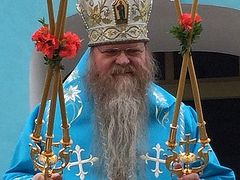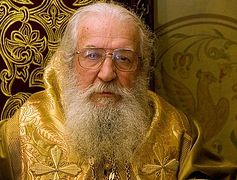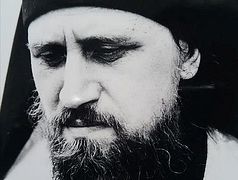 As we approach the anniversary of the repose of Archbishop Anthony (Medvedev) of San Francisco and Western America, I would like to bring up some of the characteristics of this most kind and loving archpastor.
As we approach the anniversary of the repose of Archbishop Anthony (Medvedev) of San Francisco and Western America, I would like to bring up some of the characteristics of this most kind and loving archpastor.
My first meeting with the future Archbishop Anthony was in the monastery in Ladomirovo. Vladyka Anthony, as we all know, was tonsured in Milkovo Monastery in Yugoslavia, in the very place where both of his predecessors at the Western American cathedra were tonsured: Archbishop Tikhon and St John (Maximovich). The abbot at Milkovo was Schema-Archimandrite Amvrosy. When Fr Amvrosy fell seriously ill, he transferred Hieromonk Anthony to the spiritual care of Archbishop Vitaly (Maximenko). Fr Anthony had already met him during the consecration of the latter to the episcopacy in Belgrade and immediately became an admirer. Fr Anthony was then still a hierodeacon. After Fr Amvrosy's death, Fr Anthony moved to our monastery in Ladomirovo for spiritual guidance from Vladyka Vitaly.
During the war, our brotherhood had to evacuate to Geneva. We labored there, awaiting permission to go to the USA. Fr Anthony's main tasks were the kliros and editing the calendar of divine services. He was an expert in the order of divine services and lived for them. I recall how he tried to introduce the chants of Valaam, which he had learned at Milkovo.
With the blessing of the Rector of Geneva's Elevation of the Cross Cathedral, Hieromonk Leonty (Bartoshevich), Fr Anthony tended to pastoral matters-he took confessions and ministered to the parishioners. I remember one family in which the husband and wife disagreed on church matters. Fr Anthony suffered from this disagreement, and began to visit the family frequently and talk to them on spiritual matters. But thanks to his empathetic pastoral love, he was able to influence the wife and return peace to the family.
The future Archbishop Anthony was spiritually close to the Bartoshevich brothers, Frs Leonty and Anthony, whom he knew from Yugoslavia. In Geneva, his spiritual father was Hegumen Filimon from Valaam. He was also friends with the future Archimandrite Nektary, spiritual father of Gethsemane Convent. During World War II, Hieromonk Anthony served as a chaplain to the soldiers of the Russian Emancipation Army (ROA). His closest aid was a psalm-reader, the future Fr Nektary. Vladyka Anthony remained close to Fr Nektary for the rest of their lives.
In November, 1946, our brotherhood arrived in America and settled in Jordanville. In addition to his serving on the kliros, Fr Anthony milked cows, and sometimes fell asleep under them. As Christmas approached, Archbishop Vitaly, knowing of Fr Anthony's pastoral abilities, sent him to the churches of Lakewood and St Vladimir Hill. Later, Fr Anthony founded and ministered to parishes in Lincoln, NE, Cleveland, OH, and Milwaukee, WI.
 Fr Anthony's consecration to the episcopacy for the cathedra of Melbourne, Australia, in 1956, took place in Ascension Cathedral in the Bronx, NY. I was a hieromonk at the time. I remember how he approached Metropolitan Anastassy of blessed memory, who whispered to me 'Learn, learn'' I also remember how Archimandrite Anthony, before his consecration, showed me the sermon he wrote for his nomination and asked 'What do you think?' He always sought the advice of others, even as an archpastor.
Fr Anthony's consecration to the episcopacy for the cathedra of Melbourne, Australia, in 1956, took place in Ascension Cathedral in the Bronx, NY. I was a hieromonk at the time. I remember how he approached Metropolitan Anastassy of blessed memory, who whispered to me 'Learn, learn'' I also remember how Archimandrite Anthony, before his consecration, showed me the sermon he wrote for his nomination and asked 'What do you think?' He always sought the advice of others, even as an archpastor.
Archbishop Anthony, after speaking with Bishop Averky, offered me as a candidate for the episcopacy and to be appointed Secretary of the Synod of Bishops. After my consecration, until the death of Archbishop Anthony in 2000, we were both members of the Synod of Bishops, and worked together. He was heartfelt and genuine, and never did anything for his own benefit, only for the benefit of the Church and to the glory of God. He had no personal life, only life in the Church, with Christ.
It would happen that Archbishop Anthony witnessed some trouble at the Synod. He usually shared his thoughts, wrote letters, but always in a soft tone and with obvious pain in his heart. When the proposal of glorification of the Holy New Martyrs of Russia was made, especially of the Royal Family, the bishops were not of one mind. Vladyka Anthony was a peacemaker, and always tried to reach a peaceful resolution of all matters.
I remember how Archbishop Anthony of Geneva was unhappy with the text of the services to the Royal Passion-Bearers. He thought the sticheron prayers were too long, while the canon did not address the Tsar-Martyr, but was a prayer of repentance to the Lord God. Vladyka Anthony told Vladyka Anthony (Medvedev) of San Francisco and Western America, with the hope that the latter would rewrite the texts. The latter then composed a service to all the New Martyrs and Confessors of Russia.
Both Archbishop Anthony of Geneva and Archbishop Anthony of San Francisco of blessed memory, and St John (Maximovich) had a universal view of the Church. All three hierarchs ached for the Local Orthodox Churches, for all persecuted Orthodox Christians, for the division within the Russian Church. During sessions of the Synod of Bishops, Vladyka Anthony always spoke out in support of the Serbian Orthodox Church. He was supported by Archbishop Seraphim of Chicago, Archbishop Nikon of Washington and Archbishop Anthony of Geneva. Vladyka Anthony did not defend some of the wayward actions of the Local Orthodox Churches, but felt that all Orthodox Christians must live in peace and unity.
In San Francisco, Vladyka Anthony lived alone-he cooked his own food and cleaned up himself. As a monk, his mentor had been Schema-Archimandrite Amvrossy of Milkovo, and he was trained in the old Russian school of monasticism, and remained true to this tradition to the end. Again, he never did anything for himself, only for God and the Church.
Vladyka Anthony is buried in our Holy Trinity Monastery, in a crypt behind the church. We as archpastors miss him, but I believe that he prays for us and cares for us.




